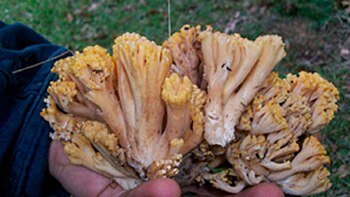
The Uruguayan Ministry of Livestock, Agriculture and Fisheries (MGAP) issued a statement last Monday alerting the growth of the fungus Ramaria (Clavaria) flavo-brunnescens or “eucalyptus fungus” in Uruguayan fields. According to the portfolio, the ingestion of the fungus produces bocopa disease that will kill livestock.
However, the ministry was mistaken in the use of this term, which is, rather, informal. “There is a big mistake in putting 'eucalyptus mushroom' as the common name of the mushroom, it is unhappy to use (that term) associating it with something toxic,” said Alejandro Sequeira, scientific disseminator and specialist in wild mushrooms, reported Montevideo Portal.
For his part, the Minister of Livestock, Fernando Mattos, told the media that it is actually a fungus of the eucalyptus type, since there are several specimens. “There are some that are harmless, others edible and others that are toxic,” said the chief and stressed that the latter is why his wallet warned. This is “the famous bocopa”, which causes illness and death to cattle and sheep.
Sequeira clarified that the error of the term “frightened people” and that is a problem because “fair is the season of consumption and collection of eucalyptus (fungus), which we all know.” The expert indicated that the name used by the ministry is “semi-correct”, because the “clavaria” thing is not like that.
The correct term to use is “toxic ramaria” and he emphasized that using “eucalyptus fungus” is incorrect. He added that the best thing would be to call the mushroom “ramaria de bocopa” to refer to the consequences it may have on livestock.

“It's true, Ramaria grows among eucalyptus, but nobody calls it 'eucalyptus mushroom'. The eucalyptus mushroom is the one they sell on the routes, the one that is collected by the mushroom trees in the forest ones, the one that is now swarming everywhere and people do it by pickling and eating with the goat. That is the eucalyptus mushroom,” Sequeira said.
In that sense, he clarified that what is called “eucalyptus mushroom” in Uruguay is the species Gymnopilus Junonius. This is the most collected and consumed type of mushroom in the country and, at this time of year, it “can be seen for sale” on the Interbalnearia route (the route that connects Montevideo with Punta del Este and the entire east coast) “along with the delicious Lactarius deliciosus (or “pine mushroom”)”.
The warning
“Bocopa is a highly toxic livestock disease, caused by the fungus Ramaria (Clavaria) flavo-brunnescens, known as Eucalyptus fungus,” says the beginning of the Livestock Ministry statement.
Currently, veterinarians from the Animal Health Division of the General Directorate of Livestock Services, are monitoring and visiting farmers' farms throughout the country, due to the occurrence of cases of poisoning in livestock by ingestion.
“This species of fungus only affects livestock and is different from the edible mushrooms that are collected at this time of year for pickled preparations or similar,” reads the statement.

The disease is of high morbidity and mortality and mainly affects cattle and sheep, although it can also occur in domestic pigs, wild boars and horses. Bocopa takes place every autumn in Uruguay, since it was first encountered by technicians in 1957.
The medical consequences are that animals lose weight, drool due to extensive ulcerations and detachment of the epithelium of the tongue, suffer claudication due to detachment of the hooves or hooves, and there is a loss of hairs, especially the tail. There are even cases involving the detachment and dropping of horns in horned animals.
In sheep, and more rarely in cattle, the disease generates symptoms such as severe nerves, seizures and hemorrhages in the anterior chamber of the eyes. The lethality reaches 38% in cattle and 49% in sheep, according to historical data from the ministry.
In fact, Bocopa is a growing disease in Uruguay, as outbreaks of the fungus increase year by year, parallel to the growth of afforestation and silvopastoral systems.
The time when it becomes crowded throughout the country is in autumn, especially after dry summers such as 2021-2022. Therefore, the ministry expects a higher number of cases in the months of April, May and June, which are the months of highest incidence and mortality.
KEEP READING:
Últimas Noticias
Debanhi Escobar: they secured the motel where she was found lifeless in a cistern
Members of the Specialized Prosecutor's Office in Nuevo León secured the Nueva Castilla Motel as part of the investigations into the case

The oldest person in the world died at the age of 119
Kane Tanaka lived in Japan. She was born six months earlier than George Orwell, the same year that the Wright brothers first flew, and Marie Curie became the first woman to win a Nobel Prize

Macabre find in CDMX: they left a body bagged and tied in a taxi
The body was left in the back seats of the car. It was covered with black bags and tied with industrial tape
The eagles of America will face Manchester City in a duel of legends. Here are the details
The top Mexican football champion will play a match with Pep Guardiola's squad in the Lone Star Cup

Why is it good to bring dogs out to know the world when they are puppies
A so-called protection against the spread of diseases threatens the integral development of dogs




